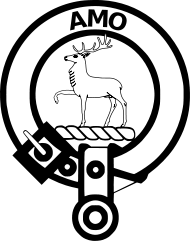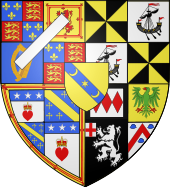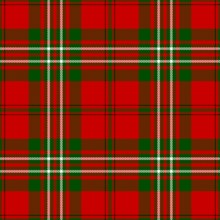- Clan Scott
-
Clan Scott Crest badge 
Crest: A stag trippant, encircled in a leather strap inscribed with the chief’s motto “Amo” meaning “I Love”. Motto: Amo ("I love") War cry: ‘a Bellendaine! ("To Bellendaine!") Also, "The Scotts are out!" Profile Region Borders Plant badge Blaeberry Chief

His Grace Richard Walter John Montagu Douglas Scott The 10th Duke of Buccleuch and the
12th Duke of QueensberrySeat Bowhill House Historic seat Dalkeith Palace Septs of Clan Scott Buccleuch, Geddes, Laidlaw, Langlangs, Allied clans Clan Douglas Rival clans Clan Kerr Clan Scott is a Scottish clan. Clan Scott is not a Highland clan but Lowland, from the Borders region of Scotland. Families and clans from this area prefer to be known as Borderers instead of Lowlanders.
Contents
History
Origins
One of the most powerful of the Border families, the name was derived from the Scots who invaded Dalriada (Argyll) from Ireland and the surname is found in all parts of Scotland. However in the Borders, an area that was never fully Gaelic speaking, it may have meant a Scottish Gaelic speaker.
The first record of the name Scott is when Uchtred filius Scot witnessed the foundation charter of Selkirk in 1120. Henricus le Scotte witnessed a charter by David Earl of Strathearn around 1195.
Michael Scott "the wizard" was a real-life scholar and philosopher, whom Walter Scott described in The Lay of the Last Minstrel as "addicted to the abstruse studies of judicial astrology, alchemy, physiognomy, and chiromancy. Hence he passed among his contemporaries for a skilful magician".[1]
In the last quarter of the 13th century the Scotts appear in Fife when Michael Lescot agreed to serve King Edward I of England overseas. (In the 17th century author Sir John Scott would rebuild Scotstarvit Tower near Cupar in Fife, a prominent landmark.)
In the Ragman Rolls (all nobles and landed gentry were required to sign by Edward I in 1296) there are six Scott lairds. One of these, Sir Richard le Scot of Murthoxton (now Murdostoun) in Lanarkshire may have acquired those lands by marriage – he also had estates in Selkirkshire. It is his line which became established and spread out between Ettrickdale and Liddesdale.
Wars of Scottish Independence
Sir Michael Scott, 2nd Laird of Buccleuch was a staunch supporter of King Robert the Bruce and distinguished himself at the Battle of Halidon Hill, fighting against the English in 1333 during the Wars of Scottish Independence.
15th century
The Lanarkshire estate was exchanged for Branxholm in Selkirkshire as the family became more and more established in the Borders. In the 15th century, as was common in the Borders, the Scotts quarrel led frequently with their neighbours, particularly the Clan Kerr. The clans would gather for battle at a place called Bellendean. The feud caused the deaths of both chiefs and was only resolved by marriage during the chieftainship of the 10th Laird. The 13th Baron was created Lord Scott of Buccleuch by James VI and in 1619 Lord Scott was created an Earl. The male line failed and Anne, Countess of Buccleuch married the illegitimate son of King Charles II, the Duke of Monmouth. Charles created the couple Duke and Duchess of Buccleuch but the Duke supported the Protestant cause and at one stage led an unsuccessful rebellion against his uncle King James II.
16th century
During the 16th century the Clan Kerr and the Clan Scott continued to raid each other's lands. The Chief Kerr of Cessford, who had worked as warden for peace and co-operation with England, was killed by a follower of Clan Scott of Buccleuch in the attempt to rescue King James V of Scotland from the Clan Douglas. In 1552 the Chief of Clan Scott of Buccleuch was killed by the Clan Kerr of Cessford in Edinburgh. Fighting between the clans continued until a peace agreement was signed in 1602.
The third Duke of Buccleuch married the heiress of the Duke of Queensberry (Clan Douglas) and became one of the richest men in Britain.
17th century
During the Civil War, Sir James Scott led his forces in support of the Covenanters at the Battle of Tippermuir in 1644 but the Covenanters were defeated by the Royalist forces under James Graham, 1st Marquess of Montrose.
18th century and Jacobite uprisings
During the Jacobite Uprisings the Clan Scott supported the British Hanoverian Government. Captain Scott was taken prisoner by the Jacobites during their first hostile action which later became known as the Highbridge Skirmish in August 1745. Later Captain Scott was released and is remembered for the successful defense during the Siege of Fort William in March 1746 where he held command and the Jacobites were defeated.
19th century
In the 19th century, Sir Walter Scott (from a junior branch, the Scotts of Harden) changed Scotland's image forever. The Duke of Buccleuch today is the largest private landowner in the United Kingdom and the art collections at the family's great houses of Drumlanrig, Bowhill and Boughton are internationally famous.
Chief
- Clan Chief: His Grace Richard Walter John Montagu Douglas Scott, The 10th Duke of Buccleuch, Duke of Queensberry, Marquess of Dumfriesshire, Earl of Buccleuch, Earl of Doncaster, Earl of Dalkeith, Earl of Drumlanrig and Sanquhar, Viscount of Nith, Torthorwald and Ross, Lord Scott of Buccleuch, Lord Scott of Whitchester and Eskdaill, Baron Scott of Tindale, Lord Douglas of Kilmount, Middlebie and Dornock.
Castles
- Branxholme Castle has been owned by the Clan Scott since 1420.
- Dalkeith Palace in Dalkeith, Midlothian, Scotland, is the former seat of the Duke of Buccleuch.
See also
Notes and references
- ^ quoted in Hogle, Jerrold E. (2002), The Cambridge companion to gothic fiction, Cambridge University Press, p. 94, ISBN 9780521794664, http://books.google.com/?id=ibKMe5iW70kC&pg=PA94
External links
Scottish clans Clans with chiefs Agnew · Anstruther · Arbuthnott · Arthur · Bannerman · Barclay · Borthwick · Boyd · Boyle · Brodie · Broun · Bruce · Buchan · Burnett · Cameron · Campbell · Carmichael · Carnegie · Cathcart · Charteris · Chattan · Chisholm · Cochrane · Colquhoun · Colville · Cranstoun · Crichton · Cumming · Darroch · Davidson · Dewar · Drummond · Dunbar · Dundas · Durie · Elliot · Elphinstone · Erskine · Farquharson · Fergusson · Forbes · Forsyth · Fraser · Fraser of Lovat · Gayre · Gordon · Graham · Grant · Gregor · Grierson · Guthrie · Haig · Haldane · Hamilton · Hannay · Hay · Henderson · Home · Hope · Hunter · Irvine · Jardine · Johnstone · Keith · Kennedy · Kerr · Kincaid · Lamont · Leask · Lennox · Leslie · Lindsay · Lockhart · Lumsden · Lyon · MacAlister · MacBain · MacDonald · Macdonald of Clanranald · MacDonald of Keppoch · Macdonald of Sleat · MacDonell of Glengarry · MacDougall · Macdowall · MacIntyre · Mackay · Mackenzie · Mackinnon · Mackintosh · Maclachlan · Maclaine of Lochbuie · MacLaren · MacLea (Livingstone) · Maclean · MacLennan · MacLeod · MacLeod of Lewis · MacMillan · Macnab · Macnaghten · MacNeacail · MacNeil · Macpherson · MacTavish · MacThomas · Maitland · Makgill · Malcolm (MacCallum) · Mar · Marjoribanks · Matheson · Menzies · Moffat · Moncreiffe · Montgomery · Morrison · Munro · Murray · Napier · Nesbitt · Nicolson · Ogilvy · Oliphant · Primrose · Ramsay · Rattray · Riddell · Robertson · Rollo · Rose · Ross · Ruthven · Sandilands · Scott · Scrymgeour · Sempill · Shaw · Sinclair · Skene · Spens · Stirling · Strange · Stuart of Bute · Sutherland · Swinton · Trotter · Urquhart · Wallace · Wedderburn · Wemyss · Wood ·
Armigerous clans Abercromby · Abernethy · Adair · Adam · Aikenhead · Ainslie · Aiton · Allardice · Anderson · Armstrong · Arnott · Auchinleck · Baillie · Baird · Balfour · Bannatyne · Baxter · Bell · Belshes · Bethune · Beveridge · Binning · Bissett · Blackadder · Blackstock · Blair · Blane · Blyth · Boswell · Brisbane · Buchanan · Butter · Byres · Cairns · Calder · Caldwell · Callender · Campbell of Breadalbane · Campbell of Cawdor · Carruthers · Cheyne · Chalmers · Clelland · Clephane · Cockburn · Congilton · Craig · Crawford · Crosbie · Cunningham · Dalmahoy · Dalrymple · Dalzell · Dennistoun · Don · Douglas · Duncan · Dunlop · Edmonstone · Fairlie · Falconer · Fenton · Fleming · Fletcher · Forrester · Fotheringham · Fullarton · Galbraith · Galloway · Gardyne · Gartshore · Ged · Gibsone · Gladstains · Glas · Glen · Glendinning · Gray · Gunn · Haliburton · Halkerston · Halket · Hepburn · Heron · Herries · Hogg · Hopkirk · Horsburgh · Houston · Hutton · Inglis · Innes · Kelly · Kinloch · Kinnaird · Kinnear · Kinninmont · Kirkcaldy · Kirkpatrick · Laing · Lammie · Langlands · Learmonth · Little · Logan · Logie · Lundin · Lyle · MacAulay · Macbrayne · MacDuff · MacEwen · MacFarlane · Macfie · Macgillivray · MacInnes · MacIver · Mackie · MacLellan · Macquarrie · Macqueen · Macrae · Masterton · Maule · Maxton · Maxwell · McCorquodale · McCulloch · McKerrell · Meldrum · Melville · Mercer · Middleton · Moncur · Monteith · Monypenny · Mouat · Moubray · Mow · Muir · Murray of Atholl · Nairn · Nevoy · Newlands · Newton · Norvel · Ochterlony · Orrock · Paisley · Paterson · Pennycook · Pentland · Peter · Pitblado · Pitcairn · Pollock · Polwarth · Porterfield · Preston · Pringle · Purves · Rait · Ralston · Renton · Roberton · Rossie · Russell · Rutherford · Schaw · Seton · Skirving · Somerville · Spalding · Spottiswood · Stewart · Stewart of Appin · Strachan · Straiton · Strange · Sydserf · Symmers · Tailyour · Tait · Tennant · Troup · Turnbull · Tweedie · Udny · Vans · Walkinshaw · Wardlaw · Watson · Wauchope · Weir · Whitefoord · Whitelaw · Wishart · Young
Culture and society Scotland · Clan chief · Septs · Clan badge · Clan crest · Clan battles · Tartan · Bagpipes · Clearances · Kilt · Manrent · The Highlands · Battle of Culloden · Highland games · Border Reivers · Scottish heraldry · Scottish surnames
Categories:- Scottish clans
- Scottish Borders
- Clan Scott
Wikimedia Foundation. 2010.

